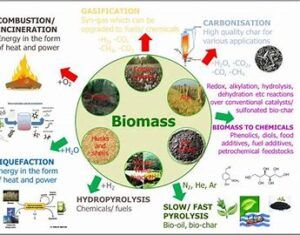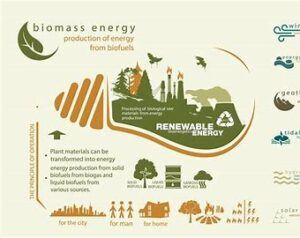When I talk about biomass, I want you to think of it as a green treasure that our planet offers in abundance. In the realm of renewable energy, ‘biomass’ refers to organic materials, such as plant matter, that store energy from the sun. This energy-intensive matter can become a source of power.
Biomass essentially comes from anything that photosynthesizes. Looking at forests, agricultural land, and even the grass in your backyard, you see potential biomass. Think of it as solar energy converted by plants into a form we can later convert into electricity, heat, or fuel.
Plants perform a bit of everyday magic through photosynthesis, absorbing sunlight and carbon dioxide to grow and store energy. That energy locked in the plants waits like a battery, ready to be harnessed by humankind.
We don’t often label plant biomass as versatile, but it is. Not only does it fuel our stoves and power plants, but it also forms the base material for biodegradable plastics, chemicals, and even certain pharmaceuticals. It stands as a testament to the versatility of nature’s processes.
Energy is everywhere – in the waste wood from a construction site, in the fallen leaves in autumn, in the residue from farm crops. With the right technology, these can all be transformed. They travel from the earth we walk on to the energy that lights up our homes.
From Earth to Energy: The Journey of Biomass
Biomass doesn’t magically turn into energy. There’s a specific process involved that transforms these organic materials into practical fuel. It starts with raw plant matter like crop residues, wood chips, and other organic waste.
You might come across several methods to convert biomass into usable energy. One common approach is direct combustion, where the biomass is burned to generate heat and, subsequently, electricity, typically in a steam turbine.
Another innovative technique is gasification. Here, biomass is converted into a gas mixture called syngas. This syngas can then be used to produce electricity or as a basic chemical feedstock for a variety of uses.
Anaerobic digestion is also gaining popularity. It involves breaking down biomass in the absence of oxygen to produce biogas. This gas primarily consists of methane, which can be burned to generate heat and electricity, or processed into renewable natural gas and transportation fuels.
These processes leverage technology to tap into biomass’s potential efficiently. By advancing these technologies, I ensure that more energy can be produced from the same amount of biomass, reducing waste and increasing sustainability.
Observing how different regions use biomass I appreciate the scale of its global influence. Some countries have integrated biomass power plants that supply significant chunks of their electricity. This trend seems to be growing, with more nations investing in biomass for its clean and renewable properties.
How Biomass Utilization Powers Our World Sustainably
Energy production is at the core of modern civilization. I turn my attention to biomass, a renewable energy source that has been gaining traction for its sustainability and versatility.
Biomass is primarily used in three sectors: heating, electricity generation, and as a biofuel for transportation. Unlike fossil fuels, biomass comes from current living organisms, most commonly plants. When I think about heating, for instance, biomass materials like wood pellets are used in stoves and boilers to provide warmth in homes and businesses.
Electricity generation from biomass involves burning plant materials or converting them into gas that drives turbines. This process creates a cycle where plant-based carbon released into the atmosphere will be reabsorbed by plants again, maintaining a balanced carbon equation.
In transportation, biomass converts to biofuels such as ethanol and biodiesel, which can replace or supplement traditional gasoline and diesel. The use of biofuels has a remarkable effect in reducing the carbon footprint of vehicles, an urgent need in the fight against climate change.
The advantages I see in biomass are not just environmental but also practical. It’s a way to manage waste materials, like crop residues and manure, by turning potential pollutants into energy.
Worldwide, there are shining examples of biomass energy solutions. Countries like Brazil have revolutionized their transportation sector with bioethanol, and in Sweden, district heating powered by biomass is a common feature.
As I prepare to transition to the next section of the article, I keep in mind that biomass isn’t just about energy production—it’s also a catalyst for economic growth. In the following section, I’ll explore how the biomass industry can contribute to job creation, support rural economies, and even increase national energy security.
Economic Growth Through Green Energy: The Biomass Advantage
The perks of biomass extend far beyond its renewable nature. It’s a powerful catalyst for economic growth, especially in rural communities where agricultural waste can turn into a valuable commodity. By investing in biomass, these areas see job creation in new sectors, from collection and transportation to technology development.
Biomass isn’t just about creating jobs; it’s about ensuring a nation’s energy security. By utilizing local resources, countries can reduce their dependence on imported fuels, which can be subject to volatile markets and geopolitical tensions. It’s a win for the local economy and a strategic move for national security.
To support this green transformation, governments worldwide are stepping up with incentives and policies. These range from tax credits for renewable energy production to grants for research into more efficient biomass technologies. Such initiatives make biomass projects not just environmentally sound but financially attractive as well.
Looking ahead, the economic implications of biomass as a key player in the global energy mix are significant. As we shift to more sustainable energy sources, biomass has the potential to power a green economic revolution, providing a reliable and cost-effective alternative to traditional fuels.



